| Listing 1 - 10 of 30 | << page >> |
Sort by
|
Book
ISBN: 0231056974 9780231056977 9780231056960 0231056966 Year: 1984 Publisher: New York (N.Y.): Columbia university press,
Abstract | Keywords | Export | Availability | Bookmark
 Loading...
Loading...Choose an application
- Reference Manager
- EndNote
- RefWorks (Direct export to RefWorks)
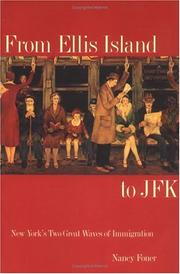
ISBN: 0300093217 0300082266 Year: 2000 Publisher: New Haven London New York Yale University Press Russell Sage Foundation
Abstract | Keywords | Export | Availability | Bookmark
 Loading...
Loading...Choose an application
- Reference Manager
- EndNote
- RefWorks (Direct export to RefWorks)
#SBIB:314H250 --- #SBIB:328H31 --- #SBIB:97G --- Migratie: algemeen --- Instellingen en beleid: VSA / USA --- Geschiedenis van Noord-Amerika --- Immigrants --- History. --- New York (N.Y.) --- Emigration and immigration --- History --- New York (State)
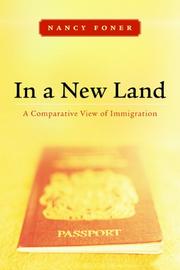
ISBN: 0814727964 1429414103 0814728596 9781429414104 9780814728598 081472745X 9780814727454 0814727468 9780814727461 9780814727966 Year: 2005 Publisher: New York : New York University Press,
Abstract | Keywords | Export | Availability | Bookmark
 Loading...
Loading...Choose an application
- Reference Manager
- EndNote
- RefWorks (Direct export to RefWorks)
2007 Choice Outstanding Academic Title!According to the 2000 census, more than 10% of U.S. residents were foreign born; together with their American-born children, this group constitutes one fifth of the nation's population. What does this mass immigration mean for America? Leading immigration studies scholar, Nancy Foner, answers this question in her study of comparative immigration. Drawing on the rich history of American immigrants and current statistical and ethnographic data, In a New Land compares today’s new immigrants with the past influxes of Europeans to the United States and across cities and regions within the United States. Foner looks at immigration across nation-states, and over different periods of time, offering a comprehensive assessment and analysis.This original approach to the study of recent U.S. immigration focuses on race and ethnicity, gender, and transnational connections. Centering her analysis on the groups that have come through and significantly shaped New York City, Foner compares today’s Latin American, Asian, and Caribbean newcomers with eastern and southern European immigrants a century ago and with immigrants in other major U.S. cities. Looking beyond the United States, Foner compares West Indian immigrants in New York with those in London. And, more generally, the book views the process of immigrants’ integration in New York against other recent immigrant destinations in Europe.Drawing on a wealth of historical and contemporary research, and written in a clear and lively style, In a New Land provides fresh insights into the dynamics of immigration today and the implications for where we are headed in the future.
Emigration and immigration --- Immigration --- International migration --- Migration, International --- Population geography --- Assimilation (Sociology) --- Colonization --- London (England) --- New York (N.Y.) --- Europe --- United States --- New York (City) --- Ni︠u︡ Ĭork (N.Y.) --- Novi Jork (N.Y.) --- Nova Iorque (N.Y.) --- Nyu-Yorḳ (N.Y.) --- Nueva York (N.Y.) --- Nu Yorḳ (N.Y.) --- Nyuyok (N.Y.) --- Nuyorḳ (N.Y.) --- New York City (N.Y.) --- Niyū Yūrk (N.Y.) --- Niyūyūrk (N.Y.) --- Niu-yüeh (N.Y.) --- Nowy Jork (N.Y.) --- City of New York (N.Y.) --- New York Stad (N.Y.) --- نيويورك (N.Y.) --- Táva Nueva York (N.Y.) --- Nyu-York Şähäri (N.Y.) --- Нью-Йорк (N.Y.) --- Горад Нью-Ёрк (N.Y.) --- Horad Nʹi︠u︡-I︠O︡rk (N.Y.) --- Нью-Ёрк (N.Y.) --- Ню Йорк (N.Y.) --- Nova York (N.Y.) --- Çĕнĕ Йорк (N.Y.) --- Śĕnĕ Ĭork (N.Y.) --- Dakbayan sa New York (N.Y.) --- Dinas Efrog Newydd (N.Y.) --- Efrog Newydd (N.Y.) --- Nei Yarrick Schtadt (N.Y.) --- Nei Yarrick (N.Y.) --- Νέα Υόρκη (N.Y.) --- Nea Yorkē (N.Y.) --- Ciudad de Nueva York (N.Y.) --- Novjorko (N.Y.) --- Nouvelle York (N.Y.) --- Nua-Eabhrac (N.Y.) --- Cathair Nua-Eabhrac (N.Y.) --- Caayr York Noa (N.Y.) --- York Noa (N.Y.) --- Eabhraig Nuadh (N.Y.) --- Baile Eabhraig Nuadh (N.Y.) --- Нью Йорк балhсн (N.Y.) --- Nʹi︠u︡ Ĭork balḣsn (N.Y.) --- Шин Йорк (N.Y.) --- Shin Ĭork (N.Y.) --- 뉴욕 (N.Y.) --- Lungsod ng New York (N.Y.) --- Tchiaq York Iniqpak (N.Y.) --- Tchiaq York (N.Y.) --- New York-borg (N.Y.) --- Nuova York (N.Y.) --- ניו יורק (N.Y.) --- New York Lakanbalen (N.Y.) --- Lakanabalen ning New York (N.Y.) --- Evrek Nowydh (N.Y.) --- Nouyòk (N.Y.) --- Bajarê New Yorkê (N.Y.) --- New Yorkê (N.Y.) --- Mueva York (N.Y.) --- Sivdad de Mueva York (N.Y.) --- סיבֿדאד די מואיבֿה יורק (N.Y.) --- Sivdad de Muevah Yorḳ (N.Y.) --- מואיבֿה יורק (N.Y.) --- Muevah Yorḳ (N.Y.) --- Novum Eboracum (N.Y.) --- Neo-Eboracum (N.Y.) --- Civitas Novi Eboraci (N.Y.) --- Ņujorka (N.Y.) --- Niujorkas (N.Y.) --- Niujorko miestas (N.Y.) --- Niuiork (N.Y.) --- Њујорк (N.Y.) --- Njujork (N.Y.) --- Bandar Raya New York (N.Y.) --- Bandaraya New York (N.Y.) --- Nuoba Iorque (N.Y.) --- Нью-Йорк хот (N.Y.) --- Nʹi︠u︡-Ĭork khot (N.Y.) --- Āltepētl Yancuīc York (N.Y.) --- Niej-York (N.Y.) --- ニューヨーク (N.Y.) --- Nyū Yōku (N.Y.) --- ニューヨーク市 (N.Y.) --- Nyū Yōku-shi (N.Y.) --- NYC (N.Y.) --- N.Y.C. (N.Y.) --- Londen (England) --- Londinium (England) --- Londres (England) --- Londýn (England) --- Lunnainn (England) --- Emigration and immigration.
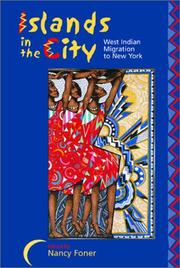
ISBN: 9786612762475 1597346888 0520935802 1282762478 9780520935808 0585391637 9780585391632 9780520225732 0520225732 9780520228504 0520228502 9781597346887 6612762470 9781282762473 Year: 2001 Publisher: Berkeley : University of California Press,
Abstract | Keywords | Export | Availability | Bookmark
 Loading...
Loading...Choose an application
- Reference Manager
- EndNote
- RefWorks (Direct export to RefWorks)
This collection of original essays draws on a variety of theoretical perspectives, methodologies, and empirical data to explore the effects of West Indian migration and to develop analytic frameworks to examine it.
Immigrants --- Blacks --- West Indian Americans --- Emigrants --- Foreign-born population --- Foreign population --- Foreigners --- Migrants --- Persons --- Aliens --- Negroes --- Ethnology --- Caribbean Americans --- West Indians --- Social conditions --- Race identity --- West Indies --- New York (N.Y.) --- New York (City) --- Ni︠u︡ Ĭork (N.Y.) --- Novi Jork (N.Y.) --- Nova Iorque (N.Y.) --- Nyu-Yorḳ (N.Y.) --- Nueva York (N.Y.) --- Nu Yorḳ (N.Y.) --- Nyuyok (N.Y.) --- Nuyorḳ (N.Y.) --- New York City (N.Y.) --- Niyū Yūrk (N.Y.) --- Niyūyūrk (N.Y.) --- Niu-yüeh (N.Y.) --- Nowy Jork (N.Y.) --- City of New York (N.Y.) --- New York Stad (N.Y.) --- نيويورك (N.Y.) --- Táva Nueva York (N.Y.) --- Nyu-York Şähäri (N.Y.) --- Нью-Йорк (N.Y.) --- Горад Нью-Ёрк (N.Y.) --- Horad Nʹi︠u︡-I︠O︡rk (N.Y.) --- Нью-Ёрк (N.Y.) --- Ню Йорк (N.Y.) --- Nova York (N.Y.) --- Çĕнĕ Йорк (N.Y.) --- Śĕnĕ Ĭork (N.Y.) --- Dakbayan sa New York (N.Y.) --- Dinas Efrog Newydd (N.Y.) --- Efrog Newydd (N.Y.) --- Nei Yarrick Schtadt (N.Y.) --- Nei Yarrick (N.Y.) --- Νέα Υόρκη (N.Y.) --- Nea Yorkē (N.Y.) --- Ciudad de Nueva York (N.Y.) --- Novjorko (N.Y.) --- Nouvelle York (N.Y.) --- Nua-Eabhrac (N.Y.) --- Cathair Nua-Eabhrac (N.Y.) --- Caayr York Noa (N.Y.) --- York Noa (N.Y.) --- Eabhraig Nuadh (N.Y.) --- Baile Eabhraig Nuadh (N.Y.) --- Нью Йорк балhсн (N.Y.) --- Nʹi︠u︡ Ĭork balḣsn (N.Y.) --- Шин Йорк (N.Y.) --- Shin Ĭork (N.Y.) --- 뉴욕 (N.Y.) --- Lungsod ng New York (N.Y.) --- Tchiaq York Iniqpak (N.Y.) --- Tchiaq York (N.Y.) --- New York-borg (N.Y.) --- Nuova York (N.Y.) --- ניו יורק (N.Y.) --- New York Lakanbalen (N.Y.) --- Lakanabalen ning New York (N.Y.) --- Evrek Nowydh (N.Y.) --- Nouyòk (N.Y.) --- Bajarê New Yorkê (N.Y.) --- New Yorkê (N.Y.) --- Mueva York (N.Y.) --- Sivdad de Mueva York (N.Y.) --- סיבֿדאד די מואיבֿה יורק (N.Y.) --- Sivdad de Muevah Yorḳ (N.Y.) --- מואיבֿה יורק (N.Y.) --- Muevah Yorḳ (N.Y.) --- Novum Eboracum (N.Y.) --- Neo-Eboracum (N.Y.) --- Civitas Novi Eboraci (N.Y.) --- Ņujorka (N.Y.) --- Niujorkas (N.Y.) --- Niujorko miestas (N.Y.) --- Niuiork (N.Y.) --- Њујорк (N.Y.) --- Njujork (N.Y.) --- Bandar Raya New York (N.Y.) --- Bandaraya New York (N.Y.) --- Nuoba Iorque (N.Y.) --- Нью-Йорк хот (N.Y.) --- Nʹi︠u︡-Ĭork khot (N.Y.) --- Āltepētl Yancuīc York (N.Y.) --- Niej-York (N.Y.) --- ニューヨーク (N.Y.) --- Nyū Yōku (N.Y.) --- ニューヨーク市 (N.Y.) --- Nyū Yōku-shi (N.Y.) --- NYC (N.Y.) --- N.Y.C. (N.Y.) --- Antilles --- Caribbean Islands --- Islands of the Caribbean --- Islands of the Atlantic --- Emigration and immigration --- Race relations --- Black persons --- Black people --- West Indian Americans -- New York (State) -- New York -- Social conditions -- Congresses.. --- West Indian Americans -- Race identity -- New York (State) -- New York -- Congresses.. --- Blacks -- New York (State) -- New York -- Social conditions -- Congresses.. --- Blacks -- Race identity -- New York (State) -- New York -- Congresses.. --- Immigrants -- New York (State) -- New York -- Social conditions -- Congresses.. --- New York (N.Y.) -- Social conditions -- Congresses.. --- New York (N.Y.) -- Race relations -- Congresses. --- 20th century. --- academic. --- afro caribbean. --- blackness. --- career. --- caribbean. --- ethnicity. --- gender studies. --- gender. --- global. --- immigrants. --- immigration. --- indian immigrants. --- islands. --- labor. --- migration. --- national identity. --- new york city. --- new york. --- political. --- politics. --- race issues. --- race. --- racism. --- regional. --- scholarly. --- second generation. --- social networks. --- transnational. --- west indian. --- womens issues. --- womens studies. --- work.
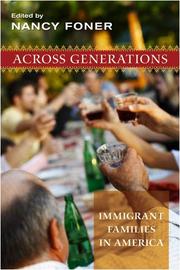
ISBN: 144161561X 0814728464 0814727859 9781441615619 9780814728468 9780814727850 9780814727706 0814727700 9780814727713 0814727719 Year: 2009 Publisher: New York : New York University Press,
Abstract | Keywords | Export | Availability | Bookmark
 Loading...
Loading...Choose an application
- Reference Manager
- EndNote
- RefWorks (Direct export to RefWorks)
Immigrants and their American-born children represent about one quarter of the United States population. Drawing on rich, in-depth ethnographic research, the fascinating case studies in Across Generations examine the intricacies of relations between the generations in a broad range of immigrant groups—from Latin America, Asia, the Caribbean, and Africa—and give a sense of what everyday life is like in immigrant families.Moving beyond the cliché of the children of immigrants engaging in pitched battles against tradition-bound parents from the old country, these vivid essays offer a nuanced view that brings out the ties that bind the generations as well as the tensions that divide them. Tackling key issues like parental discipline, marriage choices, educational and occupational expectations, legal status, and transnational family ties, Across Generations brings crucial insights to our understanding of the United States as a nation of immigrants.Contributors: Leisy Abrego, JoAnn D’Alisera, Joanna Dreby, Yen Le Espiritu, Greta Gilbertson, Nazli Kibria, Cecilia Menjívar, Jennifer E. Sykes, Mary C. Waters, and Min Zhou.
Immigrant families --- Families --- Families of emigrants --- Social conditions. --- United States --- Emigration and immigration. --- Immigration --- Families -- United States. --- Immigrant families -- United States -- Social conditions. --- United States -- Emigration and immigration. --- Across. --- Generations. --- States. --- United. --- brings. --- crucial. --- immigrants. --- insights. --- nation. --- understanding.
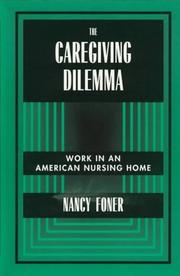
ISBN: 0520917138 0585130019 9780520917132 9780585130019 9780520203372 0520203372 0520203372 Year: 1994 Publisher: Berkeley : University of California Press,
Abstract | Keywords | Export | Availability | Bookmark
 Loading...
Loading...Choose an application
- Reference Manager
- EndNote
- RefWorks (Direct export to RefWorks)
Along with increasing life expectancy comes the knowledge that many Americans will one day enter nursing homes. Who are the people who will care for us or for our relatives? Nancy Foner provides a major study of institutional care that focuses on nursing aides, who are the backbone of American nursing homes. She examines the strains and paradoxes facing nursing aides-asked, on the one hand, to provide compassionate care and, on the other, to cope with the pressures of the workplace and the institution.Aides are expected to look after patients, who are predominantly older women, with kindness and consideration, but nursing home regulations and bureaucratic forces often hinder even the best efforts to offer consistently supportive care. Positioned at the bottom of the nursing hierarchy, aides must cope with the needs of frail, dependent residents, pressures from patients' relatives and from their own families, and demands of supervisors and coworkers.Foner's detailed description and analysis of caregiving dilemmas, based on intensive field research in a New York facility, brings the perspective of the nursing aides to the fore. This is a timely contribution to the study of work, bureaucracy, and the future of an aging American population.
Nursing home care. --- Nurses' aides --- Long-term care of the sick. --- Care of the sick --- Medical care --- Aides, Nurses' --- Assistants, Nursing --- Auxiliaries, Nursing --- Nursing assistants --- Nursing auxiliaries --- Allied health personnel --- Nurses --- Institutional care --- Long-term care of the sick --- Job stress.
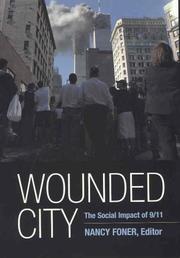
ISBN: 0871542641 0871542714 Year: 2005 Publisher: New York (N.Y.) Russell Sage Foundation
Abstract | Keywords | Export | Availability | Bookmark
 Loading...
Loading...Choose an application
- Reference Manager
- EndNote
- RefWorks (Direct export to RefWorks)
September 11 Terrorist Attacks, 2001 --- Social aspects --- New York (N.Y.) --- Social conditions.
Book
ISBN: 0520035445 Year: 1978 Publisher: Berkeley University of California press
Abstract | Keywords | Export | Availability | Bookmark
 Loading...
Loading...Choose an application
- Reference Manager
- EndNote
- RefWorks (Direct export to RefWorks)
Jamaicans --- Social status --- Foner, Nancy --- Great Britain --- Jamaica --- London (England) --- Race relations. --- Social conditions. --- Emigration and immigration.
Book
ISBN: 0231535139 9780231535137 9780231159364 0231159366 9780231159371 0231159374 Year: 2013 Publisher: New York ; Chichester, England : Columbia University Press,
Abstract | Keywords | Export | Availability | Bookmark
 Loading...
Loading...Choose an application
- Reference Manager
- EndNote
- RefWorks (Direct export to RefWorks)
In this absorbing anthology, in-depth portraits of diverse ethnic populations, including the Chinese, Dominicans, Jamaicans, Koreans, Liberians, Mexicans, and Jews from the former Soviet Union reveal surprising new realities of immigrant life in twenty-first-century New York City. Contributors show how fifty years of massive inflows have transformed New York City's economic and cultural life and how the city has changed the lives of immigrant newcomers.Nancy Foner's introduction describes how New York is special as a gateway to America, and a demographic overview chapter details the remarkable
Minorities --- Immigrants --- New York (N.Y.) --- Social conditions. --- Emigration and immigration. --- Economic conditions.

ISBN: 9781930618343 0852559429 0852559437 1930618336 1930618344 9780852559420 9780852559437 9781930618336 Year: 2003 Publisher: Santa Fe School of American Research Press
Abstract | Keywords | Export | Availability | Bookmark
 Loading...
Loading...Choose an application
- Reference Manager
- EndNote
- RefWorks (Direct export to RefWorks)
"Soaring immigration to the United States in the transitional years of the new century has awakened old fears and inspired new anxieties about the future cultural shape of this country. Yet we know little about the experience of recent immigrant communities. In this volume, nine anthropologists reflect on the history of studies of migration, evaluate anthropology's contribution to the field, and develop a research program for the future. Placing contemporary immigration in the context of globalization and transnational social fields, their essays demonstrate the importance of gender and particular urban circumstances to understanding immigrants' life worlds. Addressing issues of health care, education, and minority values and practices among Mexicans, Haitians, Somalis, Afghans, and other newcomers to the United States, the authors raise serious questions about the meaning and political uses of ideas about cultural difference." -- Back cover.
Anthropology --- Immigrants --- Research --- United States --- Emigration and immigration
| Listing 1 - 10 of 30 | << page >> |
Sort by
|

 Search
Search Feedback
Feedback About UniCat
About UniCat  Help
Help News
News